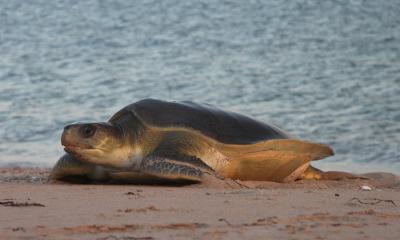Important migratory corridor for endangered marine species off north-west Australia

This is the flatback turtle in north west Australia. Credit: Paul Whittock/ Pendoley Environmental
Researchers from Deakin University, Swansea University (United Kingdom) and Pendoley Environmental consultancy used advanced satellite tracking systems to record the passage of more than 70 flatbacks off the north-west Australian coastline.
A high value migratory corridor, more than 1,000 kilometres in length, was pinpointed, with about half the corridor contained within the network of marine reserves.
“Our findings show that much of the flatback turtle's transit passage – between its breeding colonies and foraging grounds – falls within the newly established Commonwealth Marine Reserve network,” Deakin University animal movement expert Professor Graeme Hays says.
“These findings will help refine ongoing conservation planning to protect this wide-ranging turtle species using the Australian coast, including the identification of high use areas outside the existing reserve network.”
“The migration corridor is located tens of kilometres from the Australian mainland and spans tens of kilometres in width.”
“The flatback and other marine species in the area may be susceptible to accidental mortality, such as through collision with vessels and as fishery bycatch,” he says.
Tracking devices were attached to the turtle's soft shell using a flexible harness that detached after about 12 months use. A signal, depicting the turtle's position was transmitted in real-time to a constellation of satellites known as the 'Argos system' as turtles surfaced to breathe – about once every 10 to 15 minutes.
The research, published this week in Marine Biology also highlights how whales, sharks and turtles share a common migration corridor, which was previously unknown.
Professor Hays says the team's findings can help inform conservation planning to ensure the flatback turtle is protected throughout its range – which may span many hundreds or even thousands of kilometres.
“The network of Australian marine reserves may also serve as a template for marine conservation elsewhere in the world,” Professor Hays says.
“In recognition of the plight of the vulnerable flatback turtle, long-term conservation research programs are being developed to help protect this iconic species,” he says.
For more information about the research visit http://link.springer.com/article/10.1007/s00227-014-2433-7
Media Contact
More Information:
http://www.deakin.edu.auAll latest news from the category: Ecology, The Environment and Conservation
This complex theme deals primarily with interactions between organisms and the environmental factors that impact them, but to a greater extent between individual inanimate environmental factors.
innovations-report offers informative reports and articles on topics such as climate protection, landscape conservation, ecological systems, wildlife and nature parks and ecosystem efficiency and balance.
Newest articles

Superradiant atoms could push the boundaries of how precisely time can be measured
Superradiant atoms can help us measure time more precisely than ever. In a new study, researchers from the University of Copenhagen present a new method for measuring the time interval,…

Ion thermoelectric conversion devices for near room temperature
The electrode sheet of the thermoelectric device consists of ionic hydrogel, which is sandwiched between the electrodes to form, and the Prussian blue on the electrode undergoes a redox reaction…

Zap Energy achieves 37-million-degree temperatures in a compact device
New publication reports record electron temperatures for a small-scale, sheared-flow-stabilized Z-pinch fusion device. In the nine decades since humans first produced fusion reactions, only a few fusion technologies have demonstrated…





















